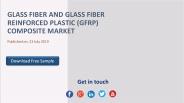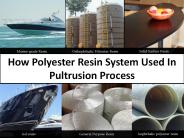Resin Impregnated Fiber Glass Banding Tape PowerPoint PPT Presentations
All Time
Recommended
Glass fiber and glass fiber reinforced plastic (GFRP) composite is a common type of fiber-reinforced plastic using glass fiber. The fibers may be randomly arranged, flattened into a sheet (called a chopped strand mat), or woven into a fabric. The plastic matrix may be a thermoset polymer matrix – most often based on thermosetting polymers such as epoxy, polyester resin, or vinylester – or a thermoplastics
| PowerPoint PPT presentation | free to download
Resiglass and Banding Tape Exporter, Polyglass Tape Manufacturer, Heat Resistant Materials, Fire Protection Sleeve, Fiber Glass Sleeve, Resin Impregnated Fiber Glass Banding Tape, Banding Tape Provider, Polyglass Tape. For more Details please visit us at : www.vardhmanresiglass.com
| PowerPoint PPT presentation | free to download
Banding Tape Supplier, Electrical Insulating Material, Heat Resistant Fabrics, Fire Protection Sleeve, High Temperature Fiber Glass, Fiber Glass Sleeve, Pyrojacket, Fiber Glass Tape, Fiber Glass Gasket Tape, Fiber Glass Tape. For more Details please visit us at : www.vardhmanresiglass.com
| PowerPoint PPT presentation | free to download
The Glass Fiber Composites market is analysed and market size information is provided by regions (countries).
| PowerPoint PPT presentation | free to download
Download free PDF Sample: https://bit.ly/39hln7z #PreimpregnatedCompositeFiber #MarketAnalysis The global Pre-impregnated Composite Fiber market is valued at US$ xx million in 2020 is expected to reach US$ xx million by the end of 2026, growing at a CAGR of xx% during 2021-2026.
| PowerPoint PPT presentation | free to download
Market Research Future Publish New Market Research Report On-“Glass Fiber Reinforced Plastic Market 2021 Global Analysis, Size, Share, Trends, Opportunities and Growth, Forecast 2027”
| PowerPoint PPT presentation | free to download
Market Research Future Publish New Market Research Report On-“Glass Fiber Reinforced Plastic (GFRP) Market 2020 Global Key Manufacturers Analysis, Sales, Supply, Demand and Forecast to 2027”
| PowerPoint PPT presentation | free to download
Download free PDF Sample: https://bit.ly/366J3Ma #GlassFiberReinforcedThermoPlasticComposite #MarketAnalysis The probable scenario is expected to grow by a xx% in 2020 and the revenue will be xx in 2020 from US$ 4526.3 million in 2019. The market size of Glass Fiber Reinforced Thermo-Plastic (GFRTP) Composite 3900 will reach xx in 2026, with a CAGR of xx% from 2020 to 2026.
| PowerPoint PPT presentation | free to download
Carbon Fiber Resin Market by Resin Type (Thermoset, Thermoplastic), by Form (Prepreg, Non-Prepreg), by Application, and by Region - Global Forecast to 2021
| PowerPoint PPT presentation | free to download
Download Sample Brochure @ http://tinyurl.com/jbd6q28 A detailed qualitative analysis of the factors responsible for driving and restraining growth of the Global Textile Glass Fibers Industry 2016 Market Research Report and future opportunities are provided in the report.
| PowerPoint PPT presentation | free to download
Glass Fiber Reinforced Plastic (GFRP) Market can have a robust growth with an astonishing CAGR during the forecast period (2017-2023), reveals Market Research Future (MRFR). The report further incorporates drivers and segmental analysis to have a comprehensive understanding of the market in coming years. Sectors such as automotive, marine and chemical have huge applications for GFRP. At the same time, increasing disposable income across the globe can boost the market further. However, glass fiber epoxy resin composites mechanical properties bear negative impacts when exposed to moisture and high temperature which can adversely affect the growth of the GFRP market. Free Sample Request at Here @ https://www.marketresearchfuture.com/sample_request/5004
| PowerPoint PPT presentation | free to download
Global Glass Fiber Reinforced Plastics Composites Market was valued at an estimated USD 46.75 billion in 2018 and this value is expected to undergo grow with a CAGR of 6.25% in the forecast period of 2019-2026, where the value will rise to 75.92 billion by 2026. The factors behind this rise in market value are its enhanced characteristics, such as high weight to strength ratio, easily molding characteristics.
| PowerPoint PPT presentation | free to download
Global glass fiber-reinforced plastics (GFRP) market is expected to rise from its initial estimated value by registering a substantial CAGR of 6.70% in the forecast period of 2019-2026. Rising installation of wind energy capacity is the major factor for the growth of this market.
| PowerPoint PPT presentation | free to download
Global glass fiber-reinforced plastics (GFRP) market is expected to rise from its initial estimated value by registering a substantial CAGR of 6.70% in the forecast period of 2019-2026. Rising installation of wind energy capacity is the major factor for the growth of this market.
| PowerPoint PPT presentation | free to download
In addition, these resins are likely to be environmentally friendly. Polyester resins increase the product's strength and allow for prevention of breakages. FRP is a polyamide that has been reinforced with glass fibers and is more commonly known as fiberglass.
| PowerPoint PPT presentation | free to download
Fiber Reinforced Plastic (FRP) market size is forecast to reach $172.2 billion by 2026, after growing at a CAGR of 4.2% during 2021-2026. Fiber Reinforced Plastic (FRP) composite is termed as a polymer that is reinforced with Fiber such as glass fiber, carbon fiber, aramid fiber, basalt fiber, and Others. The major drivers for growth in this market are increasing demand for in the transportation, construction, and electrical and electronics industry owing to its properties like light weight, high strength, resistance to corrosion and others. The epoxy and polyester resin is the foremost preference when it comes to any kind of construction like exterior and interior wall panels, beams, slabs, exterior façade, and others. The Asia-Pacific is expected to remain the largest region by value and volume and it is also expected to experience the highest growth over the forecast period.
| PowerPoint PPT presentation | free to download
Polyester resin is more commonly referred to as fiberglass or laminating resin. However, we have come across its manufacturing process and learned that fiberglass reaches in numerous shapes and has different types of glasses.
| PowerPoint PPT presentation | free to download
When a sheet of polymer or other fiber is heated in absence of oxygen at a very high temperature, then it does not burn but the carbon atoms get released. It is stabilized carbonized in the next process. The burn-resistant carbon is heated to a very high temperature in the open air. Then it is kept in a furnace filled with chemical gases. Once the process finishes, the sheet is cooled and immersed in several gases to add better bonding properties. At last, an epoxy resin is applied to the sheet. It protects the fibers from damage when they are used in various applications. Bases on the initial material used for the Fiberglass cloth, the composition of the coating changes.
| PowerPoint PPT presentation | free to download
The uses of fiberglass resins in the manufacturing sector have included fiberglass resin in manufacturing methods like the pre-pegs and fiber roving.
| PowerPoint PPT presentation | free to download
Carbon Fiber Market segmentation The carbon fiber wrap market is segmented by lay-up and application. The lay-up market is segmented into wet carbon fiber lay-up and pre-impregnated carbon-fiber lay-up. The wet carbon fiber lay-up process comprises of a dry carbon fiber film being laid over the part and resin applied by hand. The resin provides stiffness to the dry film and be used as a bonding agent for a carbon fiber wrap. In pre-impregnated process, carbon fiber is pre-impregnated with resin and doesn’t need any resin during application. Consumer goods, automobiles, and sports components use pre-impregnated carbon fiber wrap to enhance the aesthetic aspect. On the other hand, applications such as aerospace & defense, construction, wind blades & turbine use the convectional wet carbon fiber wrapping used to strengthen the structures and molds. Get Free Sample Request @ https://www.marketresearchfuture.com/sample_request/7607
| PowerPoint PPT presentation | free to download
Glassmakers have been working on glass fibers since the origin of time although industrial manufacturing also was made possible by the advent of frequently sophisticated metal fixtures.
| PowerPoint PPT presentation | free to download
Polyester resin has been judged suitable for the pultrusion process to perform continuous production in a quick curing time. It also increased the number of resources because of the presence of a large quantity of glass.
| PowerPoint PPT presentation | free to download
Also, a typical type of polyester resin is quite resistant to water. As a result, it is assumed to be one of the most beneficial for manufacturing products, usually done in small sarcastic configurations.
| PowerPoint PPT presentation | free to download
The process of removing the smell necessitates a little effort on your part, this will take more than a few hours. Fiberglass resin is very important and helps us in different situations.
| PowerPoint PPT presentation | free to download
Still, though epoxy and vinyl ester resins offer higher bonding and water and corrosion resistance, polyester continues to be the most widely used resin in the maritime industry.
| PowerPoint PPT presentation | free to download
Here in this article, various resins are available on the market for use in pultrusion & fall into 2 wide categories. These resin types have their advantages and disadvantages based on the product’s particular intent.
| PowerPoint PPT presentation | free to download
Several other uses are feasible, depending on the chemical qualities of the substance. The most common applications for this resin are found in the aerospace and automotive ambitions.
| PowerPoint PPT presentation | free to download
In the above-given knowledge, everything is precisely described regarding the formulation, uses, applications, and types of polyester resin for GP.
| PowerPoint PPT presentation | free to download
From Roman to technology era the glass for window have gone through many changes. Romans were the first to use glass window in the 100 AD. Gradually Paper windows turned out to be more economical and were being extensively used in ancient China, Korea, and Japan.
| PowerPoint PPT presentation | free to download
A glass or plastic fiber that has the ability to guide light along its axis. ... 'Fiber Optics Handbook: Fiber, Devices, and Systems for Optical Communications' ...
| PowerPoint PPT presentation | free to view
In GRP a thermoplastic resin has been used, which generally means placing under pressure. We have given you some guidelines for mixing the GRP resin effectively.
| PowerPoint PPT presentation | free to download
Polyester resin for GP has a broad variety of articles that are contemplated advantages to multiple applications that give them very compliant to connect structures like fiberglass.
| PowerPoint PPT presentation | free to download
Here in this post, all about polyester resin are the most widely used resin system, particularly in the marine industry. The resin is cured due to heating. The shape and size of the mould determine the cross-section and other features of the profile.
| PowerPoint PPT presentation | free to download
Fiber Reinforced Materials Straw in Clay (Brick, Roof, Walls) Glass Fibers in Concrete Glass Fibers in Polymer HISTORY - FRP POST WW-II APPLICATIONS Boat Hulls ...
| PowerPoint PPT presentation | free to view
The pultrusion process allows continuous production of FRP basic shapes in an automated, energy-efficient manner by pulling fiberglass wanderings through a resin bath or resin impregnator that completely immerse the reinforcements.
| PowerPoint PPT presentation | free to download
Clear here, the benefits for GRP resin India outweigh the disadvantages. However, like each material, there are invariably things to contemplate once it involves creating a call about whether or not it's the right material for your precise application.
| PowerPoint PPT presentation | free to download
Here in this post, six advantages of FRP resin in India compared to the traditional materials.
| PowerPoint PPT presentation | free to download
We are proud to say that our name is synonymous with the advent of Carbon Fiber and Fiberglass Fabrics in India. We have developed over hundreds of varieties, for an equal number of end applications. Read More Info Visit Our Site:- https://www.urjafabrics.com/
| PowerPoint PPT presentation | free to download
The design and modeling of microstructured optical fiber Steven G. Johnson MIT / Harvard University
| PowerPoint PPT presentation | free to download
Here are some best Guidelines which will Pull you out for the best information. Never directly pull on the fiber itself. Never exceed the maximum pulling load rating. Never exceed the cable bend radius. Always roll the cable off the spool instead of spinning it off the spool end. Make sure your fiber cable is long enough for the run. If Pre Terminated fiber optic cable is installed in the same tray as copper ones, always place the copper cables below. For More: https://bit.ly/2pOA9SE
| PowerPoint PPT presentation | free to download
Global Carbon Fiber Prepreg Market is expected to rise from its initial estimated value of USD 6.22 billion in 2018 to a projected value of USD 14.04 billion by 2026
| PowerPoint PPT presentation | free to download
Carbon Fiber Reinforced Plastics (CFRP) Market report categorizes global market by raw material type, resin type, manufacturing process, and application - Global Industry Insights, Trends, Outlook, and Opportunity Analysis, 2018–2026
| PowerPoint PPT presentation | free to download
Global Carbon Fiber Prepreg Market is expected to rise from its initial estimated value of USD 6.22 billion in 2018 to a projected value of USD 14.04 billion by 2026, registering a CAGR of 10.71%
| PowerPoint PPT presentation | free to download
Global Carbon Fiber Prepreg Market is expected to rise from its initial estimated value of USD 6.22 billion in 2018 to a projected value of USD 14.04 billion by 2026,
| PowerPoint PPT presentation | free to download
SPLICING OPTICAL FIBER CABLE Mohd Nasir Bin Said Telecommunication Division Electrical and Elecronics Department Fusion Splicing There are several reasons for ...
| PowerPoint PPT presentation | free to download
Get a sample brochure @ http://tinyurl.com/ztu23h4 Carbon fiber reinforced plastics (CFRP) are strong, lightweight composite materials that are used in different industries to manufacture various products. CFRPs consist of a matrix and a reinforcement, and are majorly employed to replace metals in various applications. The matrix comprises thermosetting or thermoplastic resin, and carbon fiber acts as the structural reinforcement. CFRPs have 10 times more strength as compared to steel, and weighs approximately five times less than steel. CFRP is ideal for industrial use owing to its properties such as impact resistance, strength, stiffness, flexibility, and ability to carry loads.
| PowerPoint PPT presentation | free to download
Global Carbon Fiber Prepreg Market is expected to rise from its initial estimated value of USD 6.22 billion in 2018 to a projected value of USD 14.04 billion by 2026
| PowerPoint PPT presentation | free to download
Big Market Research: “Carbon Fiber Prepreg Market 2019” Size, Share, Industry Trends, Demand, Insights, Analysis, Research, Report, Opportunities, Company Profiles, Forecast
| PowerPoint PPT presentation | free to download
Long fiber thermoplastics are a long fiber strengthened innovative structural products which usually emphasizes on semi-structural and metal replacement applications. These are designed precisely for the realization of most synergism between: style freedom, weight reduction, high performance, functions integration and per-part price economy through quick cycle times.
| PowerPoint PPT presentation | free to download
Bharatbook.com announces a new report on "Sol-Gel Processing of Ceramics and Glass", It generally refers to a low-temperature method (“sol” for solution) using chemical precursors that can produce ceramics and glass with higher purity and better homogeneity than high-temperature conventional processes.
| PowerPoint PPT presentation | free to download
“Global PBT Resins Market” report offers determining insights into the overall industry along with the market dimensions and assessment for the duration 2018 to 2025.
| PowerPoint PPT presentation | free to download
The report offers insightful and detailed information regarding key players operating in the Phenolic Resins Market & their future strategies.
| PowerPoint PPT presentation | free to download
The report offers insightful and detailed information regarding key players operating in the Phenolic Resins Market & their future strategies.
| PowerPoint PPT presentation | free to download
We’re constantly identifying and analysing high growth markets and revenue pockets. Request for a sample copy of the Fiber Reinforced Polymer Composites Market report @: https://www.globalmarketestimates.com/fiber-reinforced-polymer-composites-market/
| PowerPoint PPT presentation | free to download
Title: PowerPoint Presentation Author: Christopher Last modified by: Christopher Created Date: 1/1/1601 12:00:00 AM Document presentation format: On-screen Show (4:3)
| PowerPoint PPT presentation | free to download
The global glass filled nylon market is forecast to reach USD 11.72 Billion by 2026, according to a new report by Reports and Data. Glass filled nylon is made by adding powdered glass to the nylon resin or by extruding the plastic with glass fibers.
























































